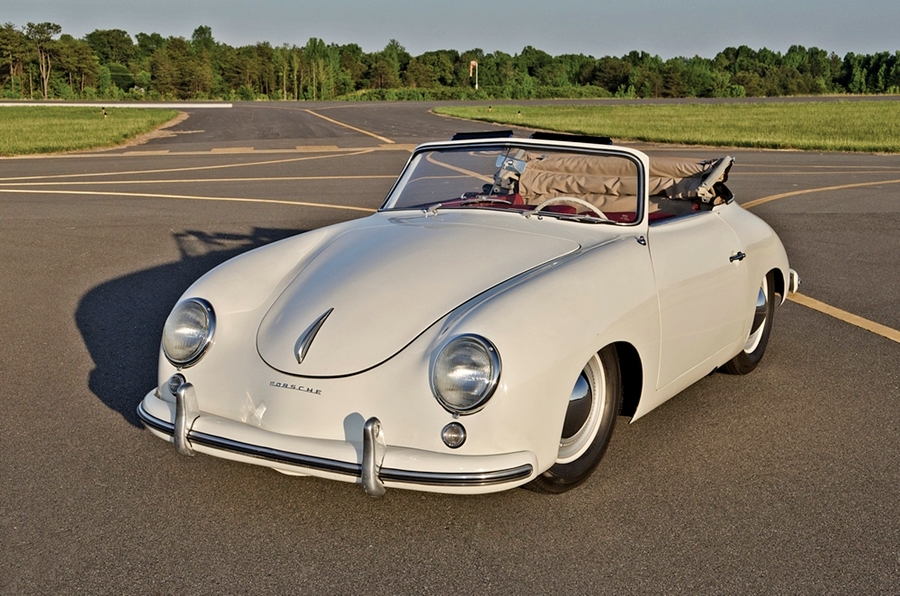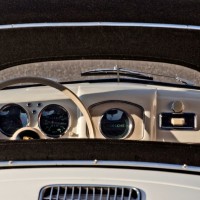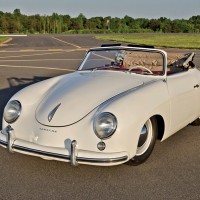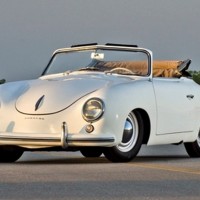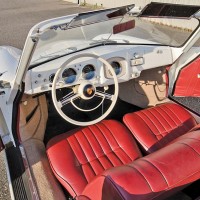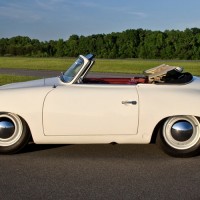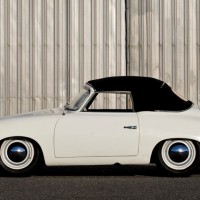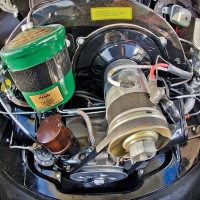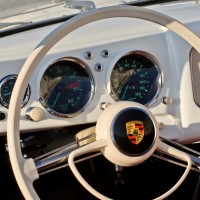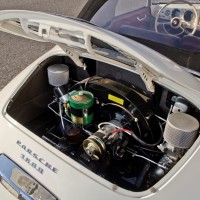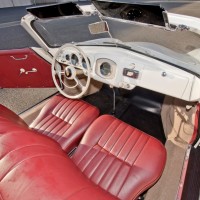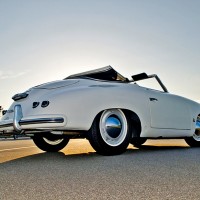- Rare pre-A model; coachwork by Reutter
- One of 394 built in 1953
- Matching numbers
- Comprehensive restoration
- Correct Ivory exterior and red leather interior
- Black convertible top
- Owner’s manual
- Kardex and Porsche Certificate of Authenticity
Number 60266 is confirmed by the included Porsche Certificate of Authenticity and Kardex as a USA-spec, pre-A 1500. It has been restored in the original R504 Ivory exterior, over a red leather interior with black convertible top.
SCM Analysis
Detailing
| Vehicle: | 1953 Porsche 356 Pre-A Reutter Cabriolet |
| Years Produced: | 1952–55 (bent-window pre-A 356s) |
| Number Produced: | 1,165 cabriolets |
| Original List Price: | $3,645 with a 55-hp Normal engine; $4,584 with a 70-hp Super engine |
| SCM Valuation: | $105,000–$120,000 |
| Tune Up Cost: | $500 to $750 with NOS wires and cap and valve adjustment |
| Chassis Number Location: | Aluminum plate to left of the gas tank; stamping on body panel in trunk just in front of the gas tank |
| Engine Number Location: | On engine case boss, under fan |
| Club Info: | 356 Registry, Porsche Club of America |
| Website: | http://www.356registry.org |
| Alternatives: | 1948–54 Jaguar XK 120, 1953–56 Austin-Healey 100, 1954 Alfa Romeo Giulietta |
This car, Lot 143, sold for $443,750, including buyer’s premium, at the Hollywood Wheels Amelia Island Select auction on March 13, 2015, at the Omni Plantation in Amelia Island, FL.
This is fulsome money for a pre-A cabriolet, which raises the question of whether pre-As are now investment-grade collectible 356s and if so, why?
Porsche 356s have a tripartite market. With 77,957 built between 1949 and 1965, they are not low-production automobiles in the manner of Ferraris of the same era. Some pockets within that model range are more scarce, however, and more desirable.
Four-cam Carreras at the top
At the pinnacle of the 356 value pyramid are the Carreras with 4-cam engines, both GSs (grand touring cars) and GTs (more sporting, typically racing variants). These higher-output Carrera engines came in three sizes:
Type 547, a 1,498-cc engine, for 1954–58.
Type 692, a 1,587-cc engine, for 1959–61.
Type 587, a 1,966-cc engine, for 1962–65.
Adding up all varieties, there were about 1,350 4-cam Carrera 356s built. The engines came in all body styles, and as you would expect, the coupes are the most common. That makes cabs — and especially Speedsters — more desirable, along with the several roadsters built with 4-cam engines in 1960–61. The Carrera market segment of 356s has been white hot for about four years now. In prime condition, the least-desirable Carreras are $750,000, and the most desirable —Speedsters and rare roadsters — are $2m and up.
Speedsters are red hot
The next pocket of desirability is the pushrod Speedsters. They were built on Pre-A 1954–55 chassis with 1,286-cc and 1,488-cc pushrod engines, and on 356 A chassis of 1956–58/9 with 1,582-cc pushrod engines. There were 4,145 Speedsters built, of which an estimated 148 were 4-cam powered, leaving 3,997 pushrod-engined cars. This market segment has been “just” red hot, with a world-record price set for a pushrod Speedster last August at Mecum Monterey of $583,500.
After the Carreras and Speedsters, the market gets complicated, with a number of models vying for position on the desirability and value scales. In this mélange, one finds 1964–65 SC cabriolets, 1962 “twin-grille” roadsters, 1960–61 “single-grille” roadsters, 1959 convertible Ds, 1964–65 356 C cabriolets, and pre-A cabs. Inclusion of the pre-A cabriolets in this grouping is a newer phenomenon.
Fifteen years ago, the pre-A model never made the discussion. As Porsche passed its 50th anniversary in 1998, attention began to turn to the earliest 356s, honing in initially on the aluminum-bodied Gmund coupes, built when the Porsche firm was in exile at a sawmill in rural Gmund, Austria. Attention rotated to split-windshield, Stuttgart-built steel-bodied cars of late 1950 through mid-1952. Last into that party were the bent-windshield, mid-1952–55 pre-As.
The bent-windshield cabriolets
Assessments of Porsches are done primarily by model, not by year, so we will focus on the mid-1952 through 1955 bent-windshield pre-A cabriolets. That number is about 1,165 cars, which is not a really low production number, but it is on the low side compared with the 4,145 Speedsters and even the 1,350 Carreras.
Among Porsche 356 aficionados, the earlier cars are considered to be somewhat quirky. The cars were genuinely handmade, with many running changes. There are even differences between cars built during the same week.
An outside supplier, Heuer, was used for some pre-A cabriolet bodies, and those cars are actually constructed differently. Most observers say the Heuer bodies aren’t built as well as the Reutter bodies. (Reutter was the on-location captive body maker until Porsche bought the firm in 1963.)
While the 1950–mid-1952 split-windshield cars generated earlier interest, interest in the bent-windshield cars started later. It got going in earnest when Road Scholars paid full retail for a no-rust, all-original-parts-intact, 30,000-mile 1952 cabriolet. It was to be fully restored. Some two years later that car, in terrific original Modegrau (Modern Gray) over gray/blue interior, hit the show circuit, to applause and envy. Pre-A cabs were on.
Good news, bad news
Now, back to the subject car, a 1953 cabriolet, s/n 60266, with a 1500 Normal engine number 32009. Little else is known about the car.
Hollywood Wheels, a relative newcomer to the Amelia Island auction scene, did not create a catalog for their Amelia auction, and their website is not fully informative. None of my friends and correspondents spent any time looking at the car. What I can say is that the car presented well, had matching-numbers mechanicals and body panels, and had original colors for paint and interior.
It had a Kardex (its Porsche Factory build and delivery card) and a Porsche Certificate of Authenticity. It also had an ill-fitting hood, overall variable panel fit, and was not at the correct ride height — especially in front.
Some trim was reproduction, and the engine designation on the rear deck was just plain wrong, 1600 instead of 1500 because the 1500 in silver/gray pot metal is not available — it has to be handmade. The engine compartment had a 1964–65 voltage regulator and incorrect side/back wall sound insulation.
A well-sold 1953 356 pre-A cabriolet
Everything considered, this cabriolet sold for strong money at $423,500, proving that at least two potential buyers loved it. My sources indicate that a Californian went to Amelia to buy pre-A 356s. He went home with four of them. Perhaps he just loves old 356s that are funky, slow and antique-like to drive. Regardless of the buyer’s motivation, this cabriolet was well sold. ♦
(Introductory description courtesy of Hollywood Wheels.)
